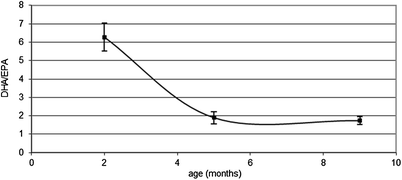Fig. 7.1
Plasma fatty acid profile in littermate dogs affected by hip dysplasia from litter 1 and 2
An interesting observation from this study is that the ratio of EPA and DHA varies with age (P < 0.01), and this was especially observed in German shepherd dogs (Fig. 7.2).


Fig. 7.2
Ratio between the fatty acids DHA and EPA with age in German shepherds (n = 6)
7.4 Discussion
In this study, the onset of articular pathologies causing osteoarthritis was not related to the diet, as only two animals were affected by hip dysplasia. In the dysplastic subjects, both German shepherds, we observed lower levels of arachidonic acid. This may be due to local utilization of this fatty acid in the area of inflammation as a precursor of pro-inflammatory molecules, although the small number of affected dogs did not allow a valid statistical analysis. In the small number of studies performed in dogs (Roush et al. 2010; Fritsch 2010), other authors only used animals affected with osteoarthritis, in which supplementation of the diet with long chain polyunsaturated fatty acids (LC-PUFAs) improved the symptoms of affected dogs and increased the plasma concentrations of LC-PUFAs in affected and control group dogs. The fact that we did not observe significant differences between the two diets might have resulted from the fact that the healthy dog is able to synthesize LC-PUFAs from the other fatty acids present in the diet, because normal dogs have normal elongase and desaturase enzymatic activity. Therefore, what we still need to answer is whether healthy dogs should be supplemented or not. According to Walters et al. (2010), PUFA supplementation of normal dogs for 21 days leads to an increase of lipid peroxidation, revealed by a reduction of GSH and an increase of isoprostane in the urine. Our results suggest that a different metabolic mode for using LC-PUFAs is probably linked to genetic factors, for example, that the activity of Δ6-desaturase in German shepherds is different from that of other breeds studied, and decreases with age. It would be of interest to investigate the genetic role that Δ6-desaturase, or other enzymes implicated in lipid metabolism, has on the incidence of osteo-articular pathologies. This might reveal the implication of LC-PUFAs in the turn-over of anti-inflammatory molecules and clarify if a specific role does exist in articular metabolism. We can conclude from this preliminary study, that the enzymatic activity of Δ6-desaturase gets reduced during the first year of life in German shepherds and that dysplastic dogs seems to have lower plasma concentrations of arachidonic acid.
Stay updated, free articles. Join our Telegram channel

Full access? Get Clinical Tree


